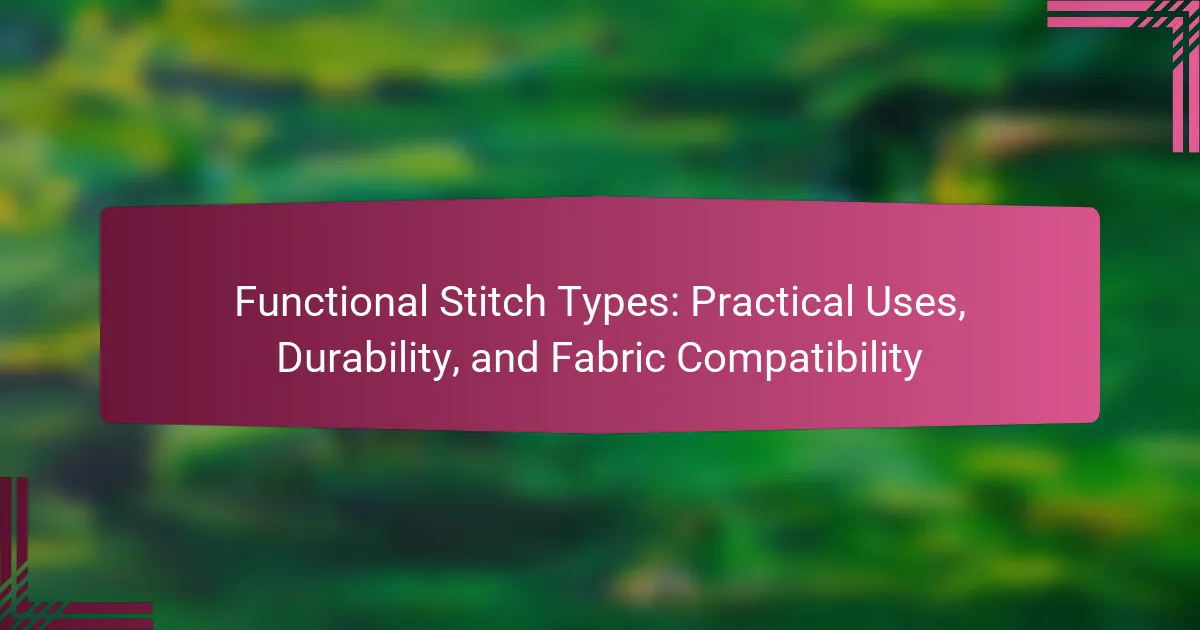
What are Functional Stitch Types?
Functional stitch types are specific sewing techniques designed to enhance the performance and durability of fabric. These stitches serve practical purposes, such as providing stretch, strength, or decorative elements. Common functional stitch types include straight stitches, zigzag stitches, and overlock stitches. Each type has unique characteristics suited for different fabric types and applications. For instance, zigzag stitches allow for fabric flexibility, making them ideal for knit materials. Overlock stitches prevent fraying by encasing fabric edges. These stitches are essential in garment construction, ensuring longevity and functionality.
How are Functional Stitch Types categorized?
Functional stitch types are categorized based on their specific applications and characteristics. The main categories include utility stitches, decorative stitches, and specialty stitches. Utility stitches are designed for basic sewing tasks and include straight, zigzag, and overlock stitches. Decorative stitches enhance the aesthetic appeal of fabrics and often feature intricate patterns. Specialty stitches address unique functions, such as stretch stitches for knit fabrics or blind hems for invisible seams. This categorization allows for better selection based on the intended use and fabric compatibility.
What are the main categories of Functional Stitch Types?
The main categories of Functional Stitch Types are utility stitches, decorative stitches, and specialty stitches. Utility stitches are designed for basic sewing tasks and include straight, zigzag, and overlock stitches. Decorative stitches enhance the visual appeal of fabric and include embroidery and satin stitches. Specialty stitches serve specific functions, such as quilt stitching or blind hemming. These categories help categorize stitches based on their primary use in sewing and garment construction.
How do different categories serve various purposes?
Different categories of functional stitch types serve various purposes based on their design and application. Each category is tailored to meet specific needs in sewing and garment construction. For instance, straight stitches are commonly used for basic seams due to their simplicity and strength. Zigzag stitches provide flexibility and stretch, making them ideal for knit fabrics.
Decorative stitches enhance the aesthetic appeal of garments while serving functional roles, such as securing layers. Specialty stitches, like overlock or cover stitches, are designed for finishing edges and preventing fraying. The choice of stitch type affects the durability and performance of the final product.
Research indicates that utilizing the appropriate stitch type can improve fabric compatibility and overall garment longevity. For example, a study published in the Journal of Textile Science found that the right stitch choice can increase seam strength by up to 30%.
What practical uses do Functional Stitch Types have?
Functional stitch types serve various practical uses in garment construction and textile applications. They enhance durability by providing strong seams that withstand stress and movement. For instance, the flatlock stitch is commonly used in activewear for its ability to reduce bulk and increase flexibility. Similarly, coverstitching is utilized in hemming knit fabrics, ensuring a clean finish while allowing stretch. Furthermore, functional stitches improve fabric compatibility by accommodating different materials, such as woven and knit fabrics. This versatility makes them essential in producing high-quality, long-lasting garments.
How do Functional Stitch Types enhance garment durability?
Functional stitch types enhance garment durability by providing stronger seams and increased resistance to wear. These specialized stitches distribute stress evenly across the fabric, reducing the likelihood of tearing. For example, flatlock stitches create a smooth finish that minimizes friction and bulk. This feature is particularly beneficial in activewear, where movement can strain seams. Additionally, reinforced stitches, such as bar tacks, add extra strength at high-stress areas like pockets and zippers. Research indicates that garments with functional stitching can last significantly longer than those with standard stitches. The combination of these techniques results in garments that withstand repeated use and washing.
What are examples of practical applications in different industries?
Functional stitch types have various practical applications across different industries. In the apparel industry, flatlock stitching is used for athletic wear to provide comfort and flexibility. The automotive industry utilizes double-stitched seams for enhanced durability in seat covers. In the upholstery sector, zigzag stitching is common for securing fabric edges to prevent fraying. The outdoor gear industry often employs waterproof stitching techniques to ensure products are weather-resistant. In medical textiles, specialized stitches are used for sutures and bandages to promote healing. Each application showcases the importance of stitch types in enhancing product performance and longevity.

How does Durability influence Functional Stitch Types?
Durability significantly influences functional stitch types by determining their suitability for various applications. Stitch types designed for high durability, such as lockstitch and flatlock, are often used in heavy-duty fabrics. These stitches provide strong seams that withstand stress and wear over time. In contrast, less durable stitches, like basting stitches, are used for temporary applications. The choice of stitch type impacts the longevity and performance of the finished product. For instance, a study by the Textile Research Journal indicated that durability is a key factor in determining stitch performance under different loads. Thus, selecting the appropriate stitch type based on durability ensures the integrity of the fabric in its intended use.
What factors contribute to the durability of Functional Stitch Types?
The durability of Functional Stitch Types is influenced by several key factors. These factors include the type of thread used, stitch density, and the fabric being stitched. High-quality threads, such as polyester or nylon, enhance durability due to their strength and resistance to wear. A higher stitch density creates more points of contact, which improves the integrity of the seams. Additionally, the compatibility of the stitch type with the fabric type plays a crucial role. For example, using a stitch designed for stretch fabrics on non-stretch materials can lead to seam failure. Research indicates that proper tension settings during sewing also contribute to the overall durability of the stitches.
How does thread type affect stitch durability?
Thread type significantly affects stitch durability. Different materials and thicknesses of thread can influence the strength and longevity of stitches. For instance, polyester thread is known for its high tensile strength and resistance to fraying, making it ideal for durable seams. Cotton thread, while softer, may not offer the same level of durability under stress. Additionally, thicker threads generally create stronger stitches compared to finer threads, which may be more prone to breaking. Research indicates that using the appropriate thread type for specific fabrics enhances the overall durability of the stitched product. For example, a study published in the Journal of Textile Science found that using nylon thread on heavy fabrics resulted in a 30% increase in stitch durability compared to cotton thread.
What role does stitch density play in durability?
Stitch density significantly affects the durability of a fabric. Higher stitch density creates a tighter weave, which enhances strength and reduces wear. This means that tightly stitched fabrics can withstand more stress and abrasion. Conversely, lower stitch density may result in weaker seams that are prone to fraying or breaking. Studies indicate that fabrics with a stitch density of 10-12 stitches per inch have better longevity compared to those with 5-7 stitches per inch. This relationship illustrates how stitch density directly influences the lifespan and performance of sewn items.
Why is fabric compatibility important for Functional Stitch Types?
Fabric compatibility is crucial for functional stitch types to ensure optimal performance and durability. When stitches are compatible with the fabric, they maintain structural integrity during use. Incompatible stitches can lead to fabric damage or seam failure. For instance, a heavy stitch on a lightweight fabric may cause tearing. Conversely, a lightweight stitch on a heavy fabric may not provide sufficient strength. Proper compatibility also affects the appearance of the finished product. Stitches that match the fabric type enhance the overall aesthetic. Research shows that selecting appropriate stitches can improve the longevity of garments and textiles. Thus, understanding fabric compatibility is essential for achieving desired functionality and quality.
How do different fabrics affect the choice of Functional Stitch Types?
Different fabrics significantly influence the choice of Functional Stitch Types. Each fabric has unique characteristics, such as thickness, stretch, and texture. For instance, lightweight fabrics like silk require finer stitches to prevent puckering. Conversely, heavier fabrics like denim benefit from thicker, more robust stitches for durability. Stretchy materials, such as spandex, necessitate specialized stitches like zigzag to allow for flexibility. Additionally, fabrics with a loose weave may require a tighter stitch to maintain structural integrity. The choice of stitch type directly correlates with the fabric’s properties to ensure optimal performance and appearance.
What are the challenges of using certain stitches with specific fabrics?
Certain stitches can pose challenges when used with specific fabrics. For example, delicate fabrics like silk may fray with heavy stitching. This can lead to damage and a poor finish. Similarly, stretchy fabrics such as knits require stitches that accommodate their elasticity. Using a standard straight stitch may cause puckering or breakage.
Heavy fabrics like denim can be difficult to sew with lighter stitches. This often results in skipped stitches or needle breakage. Additionally, some stitches may not provide adequate strength for high-stress areas. This can lead to seam failure over time.
Understanding fabric characteristics is crucial for effective stitching. Knowledge of stitch types helps in selecting the right combination for durability and aesthetics.

What are the best practices for using Functional Stitch Types?
Use the correct functional stitch type for the specific fabric and application. Selecting the right stitch enhances durability and performance. For heavy fabrics, use a straight stitch for strength. A zigzag stitch is ideal for stretchable fabrics, allowing for flexibility. Use a reinforced stitch for seams that experience stress. Ensure the stitch length is appropriate for the fabric weight; shorter stitches work better on lighter fabrics. Test the stitch on a fabric scrap before applying it to the main project. This helps in adjusting tension and stitch type as needed. Following these practices ensures optimal results in sewing projects.
How can one choose the right Functional Stitch Type for a project?
To choose the right Functional Stitch Type for a project, assess the fabric type first. Different fabrics require specific stitch types for optimal results. For instance, woven fabrics work well with straight stitches, while knits benefit from stretch stitches. Next, consider the intended use of the project. Heavy-duty items like bags need robust stitches, such as zigzag or triple-stitch. Additionally, evaluate the desired aesthetic; decorative stitches can enhance visual appeal. Finally, test the stitch on a fabric scrap to ensure compatibility and performance. This method ensures the chosen stitch meets both functional and aesthetic requirements.
What considerations should be made regarding fabric and application?
When considering fabric and application, the type of fabric directly influences the choice of stitch type. Different fabrics have varying weights, textures, and stretch characteristics. For example, lightweight fabrics may require finer stitches to avoid puckering. Conversely, heavier fabrics may need stronger stitches for durability.
The application also determines the necessary stitch type. For instance, garments that undergo significant stress should utilize reinforced stitches. Additionally, the intended use of the finished product impacts fabric selection. Outdoor gear requires weather-resistant fabrics and robust stitching.
Compatibility between fabric and stitch type is crucial for optimal performance. Poorly matched combinations can lead to seam failure or fabric damage. Understanding these factors ensures the longevity and functionality of the final product.
How can one troubleshoot common issues with Functional Stitch Types?
To troubleshoot common issues with Functional Stitch Types, first identify the specific problem. Common issues include skipped stitches, thread breakage, and uneven tension. Skipped stitches often occur due to incorrect needle size or type. Ensure the needle matches the fabric weight and stitch type. Thread breakage can result from poor-quality thread or incorrect tension settings. Use high-quality thread and adjust the tension according to the manufacturer’s guidelines. Uneven tension may be caused by improper threading or a dirty machine. Rethread the machine and clean it regularly to maintain optimal performance. Regular maintenance of the sewing machine is essential for preventing these issues. Following these steps can effectively resolve common problems associated with Functional Stitch Types.
What tips can enhance the effectiveness of Functional Stitch Types?
Use appropriate thread tension to enhance stitch quality. Proper tension prevents puckering and ensures even stitches. Choose the right needle size for the fabric type. A suitable needle prevents damage and improves [censured]. Select compatible stitch types for the fabric’s characteristics. For example, use stretch stitches on knit fabrics. Maintain consistent sewing speed for uniform stitches. This helps in achieving a professional finish. Test stitches on scrap fabric before the final project. This allows adjustments to be made for optimal results.
How can proper maintenance improve stitch longevity?
Proper maintenance can significantly improve stitch longevity. Regular cleaning of sewing machines prevents dust and lint buildup, which can weaken stitches. Lubricating moving parts reduces friction and wear, enhancing stitch quality. Checking and replacing needles regularly ensures they remain sharp, preventing fabric damage. Adjusting tension settings correctly prevents thread breakage and uneven stitching. Following manufacturer guidelines for maintenance can extend the life of both the machine and the stitches produced. Research indicates that well-maintained sewing equipment can produce stitches that last up to 30% longer than those made with poorly maintained machines.
What tools and techniques can optimize the use of Functional Stitch Types?
Tools and techniques that can optimize the use of Functional Stitch Types include specialized sewing machines and software for stitch design. High-quality sewing machines can handle various stitch types efficiently. These machines often feature adjustable tension settings for different fabrics. Additionally, using embroidery software allows for precise customization of stitch patterns.
Techniques such as proper fabric preparation enhance stitch performance. Pre-washing fabrics can prevent shrinkage and distortion. Employing stabilizers can provide support for intricate stitch types. Testing stitches on fabric scraps ensures the desired outcome before final application.
Using the right needle type is crucial for optimizing stitch quality. For example, ballpoint needles work best with knits, while sharp needles are ideal for woven fabrics. Proper thread selection also impacts stitch durability and appearance. Choosing threads designed for specific fabrics can improve overall results.
Functional stitch types are specialized sewing techniques that enhance the performance and durability of fabrics in garment construction. This article categorizes these stitches into utility, decorative, and specialty types, each serving distinct purposes based on fabric compatibility and application requirements. Key discussions include the impact of stitch types on garment durability, practical uses across various industries, and best practices for selecting and applying the appropriate stitches. Additionally, factors influencing stitch durability, such as thread type and stitch density, are examined to provide a comprehensive understanding of functional stitch types and their significance in textile applications.
